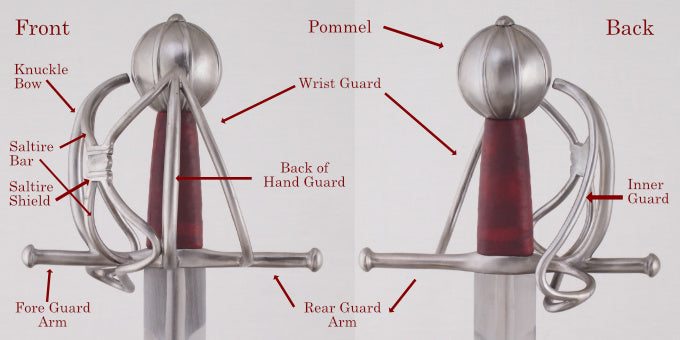The complex hilted sword is a complex subject :-), so we thought we would do a bit of a primer on these interesting swords. In this series of case studies we use some custom pieces we've done to explain the anatomy of these swords and illustrate the terminology used to describe them. Complex hilts build on the traditional cruciform (cross-shaped) hilt with the addition of bars and plates that not only protect the hand, but often become beautiful sculpture.
The terminology used to describe different types of complex hilted swords does vary, and the illustration below gives an overview that applies specifically to basket-hilted swords. While complex hilted swords share many commonalities, a scholar focused on rapiers may use some different terms from those used to describe late Scottish Basket hilts. In each installment of this series we lay out the proper terms for the sword or swords featured that day.

Basket terms for basket hilt components.

The first piece we will look at is a reproduction of a sword that was recovered from the wreck of the Mary Rose, Henry VIII's ill-fated flagship which sank in 1545. Thus, the provenance of this sword for use and dating is rock solid. It is most certainly a high-status piece, being part of the equipment on this vessel which was stocked with the latest and best equipment of the day. It has some refined details, like the ribbed pommel and the fine file work on the saltire plate which also indicate this was a "nice" sword in its day.

Illustration of the Mary Rose
In the case of the Mary Rose sword we will draw your attention to a couple of nice attributes of this sword. One is the hollow pommel. This gives the sword the distinct look it has with little of the weight if such a large pommel was solid. The walls of the pommel on our reproduction are a bit over 1/8" thick.
Overall image of Mary Rose Basket hilt.
The second feature is the "saltire bars" which are distinct on this hilt. They are the pair of bars that form an X shape in the space between the knuckle bow and the back of the hand bar on the front of the hilt. These are elements that will become quite common on basket hilts as they develop and will be seen on many of the English and Scottish baskets from this period forward.
Check out our video as we look at some interesting complex hilts and we hope you find the info useful in your study of the sword.

Nathan Clough, Ph.D. is Vice President of Arms and Armor and a member of the governing board of The Oakeshott Institute. He is a historical martial artist and a former university professor of cultural geography. He has given presentations on historical arms at events including Longpoint and Combatcon, and presented scholarly papers at, among others, The International Congress on Medieval Studies.
Craig Johnson is the Production Manager of Arms and Armor and Secretary of The Oakeshott Institute. He has taught and published on the history of arms, armor and western martial arts for over 30 years. He has lectured at several schools and Universities, WMAW, HEMAC, 4W, and ICMS at Kalamazoo. His experiences include iron smelting, jousting, theatrical combat instruction and choreography, historical research, European martial arts and crafting weapons and armor since 1985.

